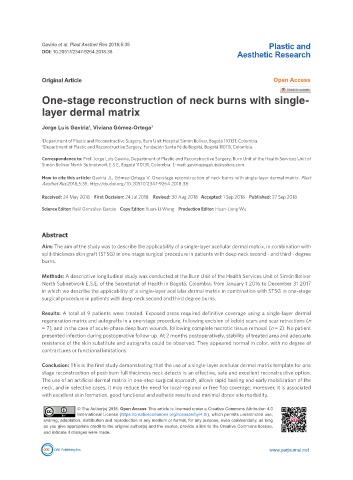Page 249 - Read Online
P. 249
Gaviria et al. Plast Aesthet Res 2018;5:35 Plastic and
DOI: 10.20517/2347-9264.2018.38 Aesthetic Research
Original Article Open Access
One-stage reconstruction of neck burns with single-
layer dermal matrix
Jorge Luis Gaviria , Viviana Gómez-Ortega 2
1
1 Department of Plastic and Reconstructive Surgery, Burn Unit Hospital Simón Bolivar, Bogotá 110131, Colombia.
2 Department of Plastic and Reconstructive Surgery, Fundación Santa Fé de Bogotá, Bogotá 110111, Colombia.
Correspondence to: Prof. Jorge Luis Gaviria, Department of Plastic and Reconstructive Surgery, Burn Unit of the Health Services Unit of
Simón Bolívar North Subnetwork E.S.E, Bogotá 110131, Colombia. E-mail: gaviriajorgeluis@yahoo.com
How to cite this article: Gaviria JL, Gómez-Ortega V. One-stage reconstruction of neck burns with single-layer dermal matrix. Plast
Aesthet Res 2018;5:35. http://dx.doi.org/10.20517/2347-9264.2018.38
Received: 24 May 2018 First Decision: 24 Jul 2018 Revised: 30 Aug 2018 Accepted: 1 Sep 2018 Published: 27 Sep 2018
Science Editor: Raúl González-García Copy Editor: Yuan-Li Wang Production Editor: Huan-Liang Wu
Abstract
Aim: The aim of the study was to describe the applicability of a single-layer acellular dermal matrix, in combination with
split-thickness skin graft (STSG) in one-stage surgical procedure in patients with deep neck second - and third - degree
burns.
Methods: A descriptive longitudinal study was conducted at the Burn Unit of the Health Services Unit of Simón Bolívar
North Subnetwork E.S.E. of the Secretariat of Health in Bogotá, Colombia, from January 1 2016 to December 31 2017
in which we describe the applicability of a single-layer acellular dermal matrix in combination with STSG in one-stage
surgical procedure in patients with deep neck second and third degree burns.
Results: A total of 9 patients were treated. Exposed areas required definitive coverage using a single-layer dermal
regeneration matrix and autografts in a one-stage procedure, following excision of keloid scars and scar retractions (n
= 7), and in the case of acute-phase deep burn wounds, following complete necrotic tissue removal (n = 2). No patient
presented infection during postoperative follow-up. At 2 months postoperatively, stability of treated area and adequate
resistance of the skin substitute and autografts could be observed. They appeared normal in color, with no degree of
contractures or functional limitations.
Conclusion: This is the first study demonstrating that the use of a single-layer acellular dermal matrix template for one
stage reconstruction of post-burn full thickness neck defects is an effective, safe and excellent reconstructive option.
The use of an artificial dermal matrix in one-step surgical approach, allows rapid healing and early mobilization of the
neck, and in selective cases, it may reduce the need for local-regional or free flap coverage; moreover, it is associated
with excellent skin formation, good functional and esthetic results and minimal donor site morbidity.
© The Author(s) 2018. Open Access This article is licensed under a Creative Commons Attribution 4.0
International License (https://creativecommons.org/licenses/by/4.0/), which permits unrestricted use,
sharing, adaptation, distribution and reproduction in any medium or format, for any purpose, even commercially, as long
as you give appropriate credit to the original author(s) and the source, provide a link to the Creative Commons license,
and indicate if changes were made.
www.parjournal.net

